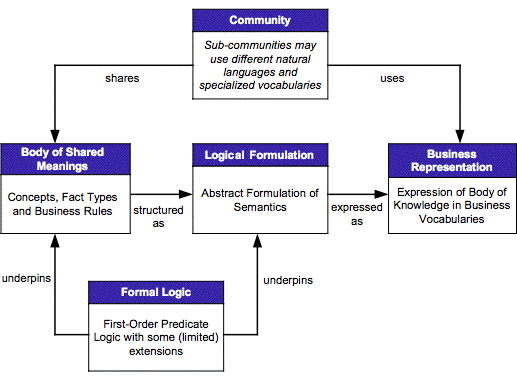SBVR Speaks: (2) The Five Major Aspects of SBVR
In January 2008, the "Semantics of Business Vocabulary and Business Rules" (SBVR) was first presented by the Object Management Group (OMG) as an official specification of the OMG. Version 4 (SBVR 1.4) was published in 2017.[1]
This instalment continues the exploration of the "Semantics of Business Vocabulary and Business Rules" (SBVR) with a look at its five major aspects, as illustrated below.

Community
The basis for business vocabulary is community. At the business level, the communities of primary importance are the enterprises for which business rules are being established and expressed. However, other communities (for example, the industry in which an enterprise operates, partner enterprises, standards groups, regulatory authorities, etc.) also need to be recognized. For example, for the fictitious car rental company EU-Rent (which is included in SBVR as an appendix), EU-Rent itself is a community, as is the Car Rental Industry.
An important aspect of community is that 'sub-communities' within an enterprise may need its body of shared meanings to be expressed in different vocabularies, ranging from specialized jargon to different natural languages. In SBVR, such sub-communities are called 'speech communities'. For example, EU-Rent has English and German sub-communities (different natural languages) as well as a sub-community that is composed of its HQ Staff (specialized, local jargon).
Body of Shared Meanings
A community has a body of shared meanings, comprising its concept model (the shared concepts, including verb concepts) and its business rules. It is important to emphasize that what is shared is the meaning, not the form of expression — although, clearly, for shared meanings to be exchanged, discussed, and validated, they must be expressed.
An important feature of SBVR is its separation of the business meaning from any particular form of expression. The structure of the body of shared meanings (i.e., which concepts play which roles in facts, which facts form the basis of which rules, etc.) is defined by associating abstract concepts, verb concepts, and business rules, not by associating statements in any particular language.
Logical Formulation
Logical formulation provides a formal, abstract, language-independent syntax for capturing the semantics of a body of shared meanings. It supports multiple forms of representation, such as: noun and verb forms of expression, and the reading of associations in both directions.
Logical formulation supports two essential features of SBVR. First is the mapping of a body of shared meanings to vocabularies used by communities. Second is the mapping to XMI that enables interchange of concepts, facts, and business rules between tools that support SBVR.
Business Representation
The concepts and business rules in a body of shared meanings need to have a business representation in a vocabulary that is acceptable to, and usable by, the speech communities that share an understanding of the meanings. These vocabularies may be in different natural languages, in artificial languages such as the UML, or in specialized subsets of natural languages, as used by (for example) engineers or lawyers.
SBVR supports mapping of business meaning to concrete language by associating elements of the body of shared meanings with signifiers, e.g., terms such as 'customer', 'car', 'branch' for concepts, and verb symbols (often verb phrases) such as 'rents' and 'is located at' for verb concepts. Logical formulations provide the structure, and signifiers are placed in logical formulations to provide the expression.
SBVR supports adoption from external sources, such as standards bodies and industry groups. For example, SBVR itself adopts some of its basic definitions from ISO standards for terminology and vocabulary (ISO 1087-1[3] and ISO 704[4]).
Formal Logic
SBVR has a sound theoretical foundation of formal logic, underpinning both logical formulation and the structures of bodies of shared meanings. The base is first-order predicate logic (with some restricted extensions into higher-order logics), with some limited extensions into modal logic — notably some deontic forms, for expressing obligation and prohibition, and alethic forms for expressing necessities.
References
[1] Semantics of Business Vocabulary and Business Rules (SBVR). Object Management Group.
The current version of SBVR is available on the OMG
site. ![]()
[2] Quick Reference for Basic SBVR Terminology (v. 2)
[3] International Organization for Standardization (ISO). Terminology work — Vocabulary — Part 1: Theory and Application. English/French ed.:
ISO (2000). ![]()
[4] International Organization for Standardization (ISO). Terminology work — Principles and Methods. English ed.:
ISO (2000). ![]()
# # #
About our Contributor:
Online Interactive Training Series
In response to a great many requests, Business Rule Solutions now offers at-a-distance learning options. No travel, no backlogs, no hassles. Same great instructors, but with schedules, content and pricing designed to meet the special needs of busy professionals.











